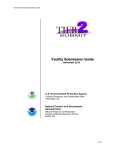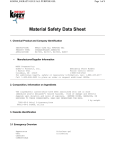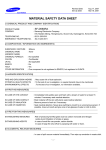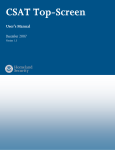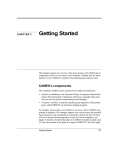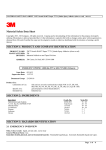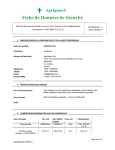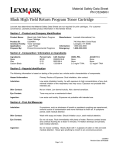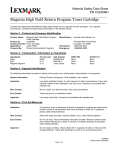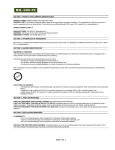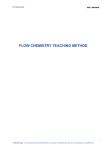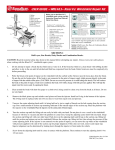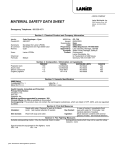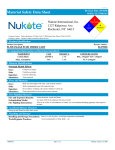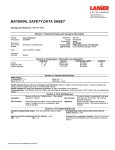Download 185K - CHAUVET® Lighting
Transcript
Safety Data Sheet May be used to comply with OSHA's Hazard Communication Standard, 29 CFR 1910.1200. Standard must be consulted for specific requirements. IDENTITY (As Used on Label and List) Chauvet Fog Fluid Item# FJU U.S. Department of Labor Occupational Safety and Health Administration (Non-Mandatory Form) Form Approved OMB No. 1218-0072 Note: Blank spaces are not permitted. If any item is not applicable, or no information is available, the space must be marked to indicate that. Section I: Product and Company Identification Manufactured exclusively for: Emergency Telephone Contact Number Chauvet 954-577-4455 Address Telephone Number for Information 5200 NW 108th Avenue 954-577-4455 Sunrise, FL 33351 Date Prepared Signature of Preparer (optional) August 2014 Section II: Hazard(s) Identification Hazardous Components (Specific Chemical Identity; Common Name(s)) OSHA PEL Other Limits ACGIH TLV Recommended This product is a filtered blend of polyfunctional alcohol regularly used by the food and cosmetics industry. Main competent of the product is water. This material is not considered to be hazardous according to regulatory guidelines. Routes of Exposure: Eye contact, Skin Contact, Inhalation, Ingestion. Health Hazards (Acute and Chronic) May cause slight eye, skin and respiratory tract irritation. Carcinogenicity: NTP: IARC Monographs: Not listed Not listed Not listed OSHA Regulated: Not listed Signs and Symptoms of Exposure Prolonged exposure may cause flacking and softening of skin. Mist may cause irritation of upper respiratory tract. Medical Conditions Generally Aggravated by Exposure None known. Chauvet Fog Fluid Item# FJU Section III – Composition / Information on Ingredients No reportable Hazardous Substance(s) or Complex Substance(s). Grignard company LLC withholds the specific chemical identity and/or exact percentages of the composition of our products due to this information being a part of our Intellectual Property. Section IV: First Aid Measures Eyes: Immediately flush eyes thoroughly with water at least for 15 minutes. If irritation occurs, get medical assistance Inhalation: Move victim to fresh air. If symptoms persist, get medical attention. Skin: Flush affected area with plenty of water for at least 15 minutes. Remove contaminated clothing and shoes. Get medical attention if irritation occurs. Ingestion: If affected person is conscious, give water. Do not induce vomiting. Call for medical attention. Section V: Fire – Fighting Measures Flash Point (Method Used) Flammable Limits LEL UEL Not Flammable by WHMIS/OSHA criteria NA N/D N/D Extinguishing Media Use anti-alcohol foam, dry chemical powder, CO2, water fog Special Fire Fighting Procedures Move container from fire area if you can do it without risk. Wear Self-contained breathing apparatus and full protective clothing Unusual Fire and Explosion Hazards None Section VI: Accidental Release Measures Personal Precautions: Avoid contact with liquid and inhalation of vapors. Wear protective clothing described in section 8. Environmental precautions: Avoid the spillages to sewer and drains. Avoid dispersion of product Method for Clean Up: Ventilate area of spill or leak. Isolate and remove discharge material with absorbent dry sand. 2 Chauvet Fog Fluid Item# FJU Section VII: Handling and Storage Handling Wear appropriate protective clothing to avoid contact or inhalation of the product. Do not smoke, drink or eat. Wash hands using liquid detergent. Eliminate all sources of ignition from areas where the material is handled or used; no sparks or flames in hazard area. Storing Store at room temperature in opaque, properly labelled and closed containers. Keep in wellventilated area and protected from sunlight. Section VIII: Exposure Controls/Personal Protection Respiratory Protection (Specify Type) Normally not required. In presence of high concentrations of vapors, respiratory protective mask with filter against organic vapors is recommended. Ventilation Local Exhaust Special Recommended Mechanical (General) Other Protective Gloves: Eye Protection Impervious gloves. Safety goggles to avoid splashes Other Protective Clothing or Equipment Eye washers and showers in working area Work/Hygienic Practices: Handle in accordance with good industrial hygiene and safety practice. Do not drink or eat when using product. Wash hands before breaks and immediately after handling the product. Section IX: Physical and Chemical Properties Boiling Point Specific Gravity (H2O = 1) N/A Vapor Pressure (mm Hg.) Vapor Density (AIR = 1) N/A N/A Melting Point Evaporation Rate (Butyl Acetate = 1) 1.04 N/A N/A Solubility in Water: Completely Miscible Physical State: Liquid Appearance: Transparent and clear Odor: Odorless 3 Chauvet Fog Fluid Item# FJU Section X: Stability and Reactivity Stable Stability: Hazardous Polymerization: Will Not Occur Incompatibility (Materials to Avoid): Strong oxidizing agents, strong acids and strong bases. Conditions to Avoid: High temperatures and direct sunlight exposures. Possibility of Hazardous Reactions: Will not occur Hazardous Decomposition Products: Carbon monoxide, Carbon dioxide and water. Section XI: Toxicological Information Toxicological Information: Skin: The LD50 for skin absorption in rabbits is > 5000mg/kg Ingestion: The oral LD50 for rats is 16,800 – 22,060 mg/kg Inhalation: The aerosol LC50 for rats is > 4.5mg/L Acute and Chronic effects: Prolonged or repeated exposure may cause skin irritation. May cause more serve response if skin is abraded. Single dose oral toxicity is considered to be low. May cause stomach distress. If swallowed, seek medical attention. Carcinogenicity/Other Information: None of the components are listed by: NTP, IARC, ACGIH, OSHA Reproductive Toxicity: Non-hazardous by WHMIS/OSHA criteria Section XII: Ecological Information Toxicity: Not applicable Biodegradability: Not applicable Bio-accumulative potential: Not Applicable Other Adverse Effects: Not Applicable 4 Chauvet Fog Fluid Item# FJU Section XIII: Disposal Considerations Disposal Recommendations: Do not discharge into waterways, sewers, basements or confined areas. Follow federal, state, provincial and local government requirements for waste. Section XIV: Transportation Land (DOT): Not regulated for Land Transport Land (TDG): Not regulated for Land Transport Sea (IMDG): Not regulated for Sea Transport according to IMDG-Code Air (IATA): Not regulated for Air Transport Section XV: Regulatory Information OSHA Hazard Communication Standard: When used for its intended purposes, this material is not classified as hazardous in accordance with OSHA 29 CFR 1910.1200. EPCRA: This material contains no extremely hazardous substances. SARA (311/312) Reportable Hazard Categories: None SARA (313) Toxic Release Inventory: This material contains no chemicals subject to the supplier notification requirements of the SARA 313 Toxic Release Program. The Following Ingredients are Cited on the Lists Below: None Section XVI: Other Information Other Special Considerations: None Disclaimer: This information is to the best of our knowledge and belief, accurate and reliable as of the date complied. However, no representation, warranty or guarantee is made as to its accuracy, reliability or completeness. It is the user’s responsibility to satisfy himself as to the suitability and completeness of such information for his own particular use. We do not accept liability for any loss or damage that may occur from the use of this information nor do we offer warranty against patent infringement. 5





